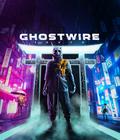Pre-order Ghostwire: Tokyo
I've spent some time in the fog while playing Ghostwire: Tokyo — clearing it up, avoiding it, trying to see through it, fighting monsters emerging from it. It's meant to be a constant, eerie presence, a reminder to the game's heroes about a cataclysmic event that raises questions only they can find the answers to. It's also the omen of a theoretical shift for Tango Gameworks: Instead of a fear-inspiring walkthrough nightmare, this next piece of work will let players smack those nightmares in the face with magic.
It's a little surprising, considering Tango's history. Its founder, Shinji Mikami, is one of the godfathers of survival horror, and The Evil Within games were welcome entries in an expansive library of freakish sci-tales that Mikami and company helped build. However, while there's certainly an air (or fog, rather) of unsettling weirdness to be found in Ghostwire: Tokyo, what we'll be getting most of the time is frantic, high-pressure action.
The game's initial setting: A thick, mysterious fog sweeps through Tokyo, clearing out the population by essentially turning everyone into spirits and making their bodies go poof. Piles of clothes are now scattered around the once-bustling streets of the city, along with a skulking, floating zootopia of faceless, headless and likely soulless creatures called the Visitors.
You occupy the body of Akito, a 20-something student in Tokyo who actually died when all this went down, only to be possessed and resurrected by KK, who comes across as a sort of Constantine-adjacent ghost/creature hunter who bestows a variety of magical fighting abilities upon Akito and basically drafts him to fight against Tokyo's new denizens, serving as an advisory voice-in-the-head. Akito has a stake in the game as well, as his sister Mari gets abducted by the game's central villain, a superpowered man known only as Hannya because of the theatrical demon mask he wears.
At a glance, the gameplay is an assembly of familiar open-world and shooter elements. But instead of guns, Akito unleashes a variety of upgradeable elemental magic through his hands and utilizes a magic wire to pull out the "cores" of weakened enemies. This leads to a unique aesthetic of hand gestures as Akito fires various magic blasts from his fingertips. The designers' aim is to give a sort of magic-fu feel to the action, and thus far, it works. As a stealth change-up, Akito also gets to use a customized bow-and-arrow that can take out some enemies with a single shot. A press of the left shoulder button enables an ethereal "block" that can parry or deflect certain attacks when timed well.
These pieces comprise a fine combat system. The skirmishes I've encountered reflect the kind of shooter chaos one would encounter in Doom — but a touch slower. The stable of Visitor/enemy designs is strangely diverse, like headless schoolgirls and gaunt, umbrella-wielding men in suits.
There looks to be a massive amount of things to do in this game away from the main quest, but all could contribute to Ghostwire's budding spiritual sub-universe. It's an encyclopedia of Japanese myths and legends. When he's not pursuing the man in the Hannya mask, Akito can "collect" lost spirits in katashiro, which is a paper talisman used for purification. He can then take this talisman to a pay phone that's amazingly been rigged up with tech to "absorb" the spirits in the hopes of eventually returning them, somehow, to their bodies. Doing this also gives Akito more experience points to level up.
The side missions could be the star of the Ghostwire experience, potentially to color in the lines of Akito and KK's relationship. The banter so far has been fun, and I look forward to seeing how their buddy-cop vibe develops as KK serves as Akito's phantasmal sensei.
The side missions can give you the feeling of being a friendly neighborhood ghostbuster. The missions come from spirits with something to say, and you find them as you "cleanse" torii gates around the city and clear up the fogged areas of the map. Akito can't walk through the fog either, as it's actually harmful to him, like poison gas or acid mist. The things Akito can be asked to do from these spirits could range from the mundane to the eerily spectacular. A lot of it involves purging malicious spirits. Getting rid of these guys is fun, as the player is asked to "trace" a kind of pattern with the right thumbstick, then "release" the spirit once you do it correctly. Or you can just let KK take over Akito's body, and he can do it. The side missions also offer intriguing peeks into Japanese culture, taking on topics such as workplace culture or greed.
One thing that surprised me was Akito's apparent freedom of movement around the city. Akito can "glide" through the air, lengthening jumps he can take and adding a layer to his traversal of rooftops. The potential verticality of the exploration carries a lot of promise, whether you're trying to collect spirits or in what main quest missions could offer.
Visually, Ghostwire: Tokyo looks crisp and worth exploring. The streets and cityscape have moments of illuminated beauty despite being devoid of human activity, and some of Tango's signature dark imagery consistently finds its way to the viewers' eyes.
So far, I'd classify what I've faced in Ghostwire: Tokyo as a romp through ghostly chaos. It's quite a departure from what one could expect from such a horror-oriented studio, but Tango deserves some extra respect for trying. Let's see if they can pull it off when the game releases later this month.
More articles about GhostWire: Tokyo











 GhostWire: Tokyo is an action-adventure where you face off against dangerous spirits and fight to purge Tokyo of evil as you unravel the mystery behind a mass disappearance.
GhostWire: Tokyo is an action-adventure where you face off against dangerous spirits and fight to purge Tokyo of evil as you unravel the mystery behind a mass disappearance.






















